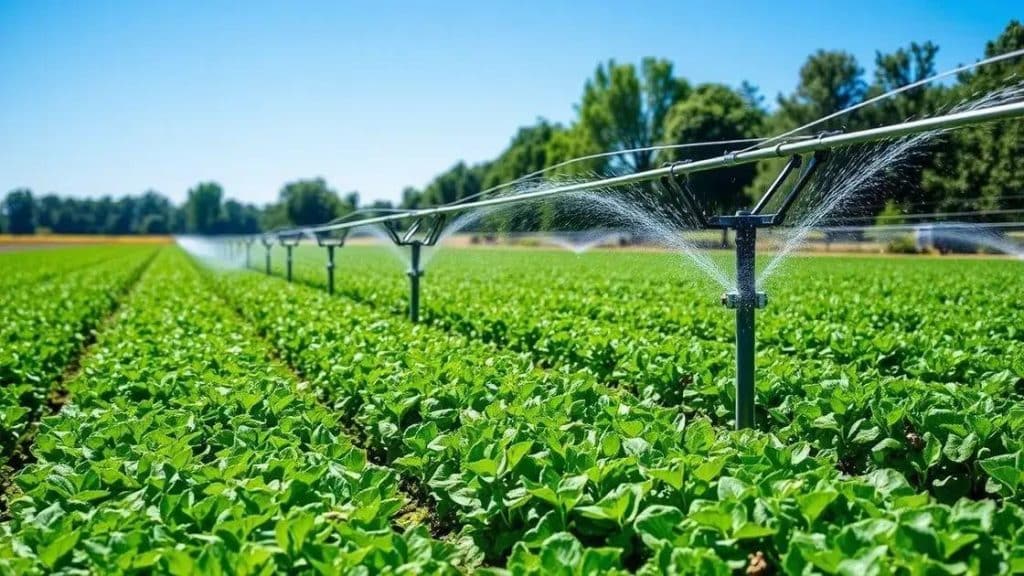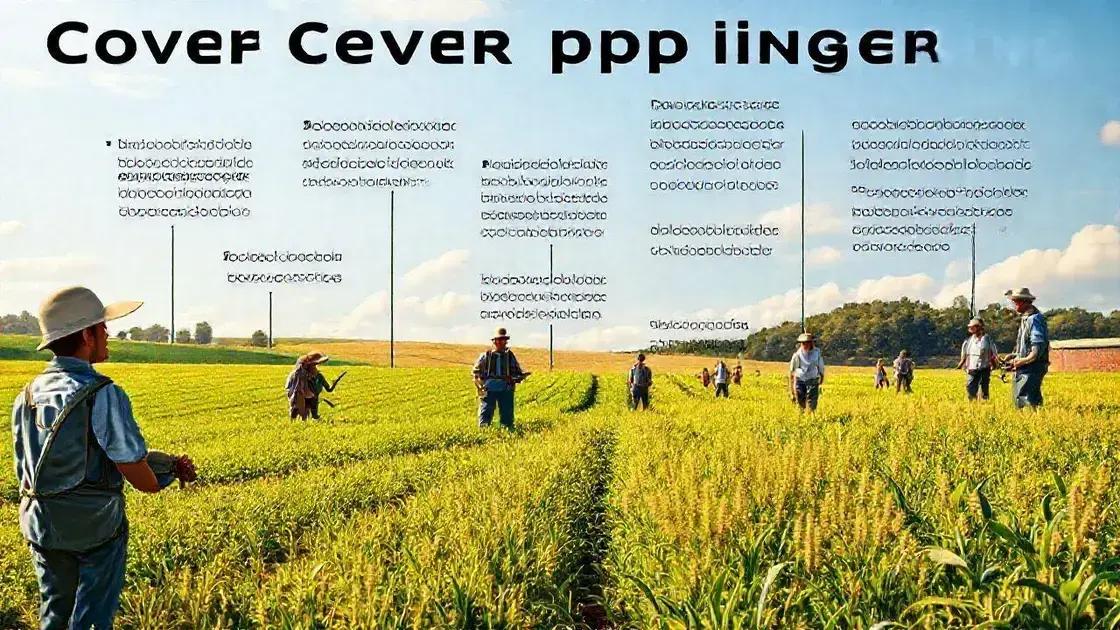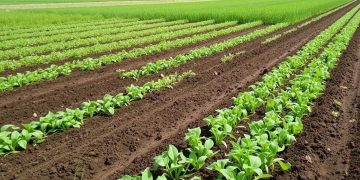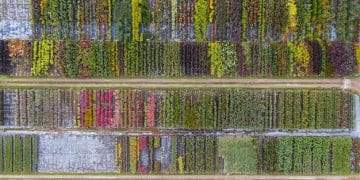Cover cropping techniques for soil regeneration

Cover cropping techniques improve soil health by enhancing fertility, preventing erosion, and suppressing weeds, making them essential for sustainable farming practices.
Cover cropping techniques for soil regeneration can transform your farming practices. Curious about how these strategies improve soil health? Let’s dive in and explore the benefits and methods that can make a difference in your garden or farm.
Understanding cover cropping and its benefits
Understanding cover cropping is essential for anyone interested in improving soil health and supporting sustainable farming practices. Cover crops are plants grown primarily for soil benefits rather than for harvest. They play a crucial role in enhancing soil fertility and reducing erosion.
Benefits of Cover Cropping
There are numerous advantages to implementing cover crops in agricultural systems. Some of the key benefits include:
- Improved Soil Structure: Cover crops help to aerate the soil and improve its texture, making it easier for roots to penetrate.
- Nutrient Cycling: They can increase the availability of nutrients by capturing and releasing them when needed.
- Erosion Control: Growing cover crops reduces soil erosion caused by wind and water.
- Weed Suppression: By covering the ground, these plants can effectively outcompete weeds for resources.
When selecting appropriate cover crops, it’s important to consider your soil type and the specific benefits you wish to achieve. For example, legumes are excellent for fixing nitrogen in the soil, while deep-rooted plants can help break up compacted layers.
Types of Cover Crops
Different cover crops are suitable for various conditions. Some common types include:
- Legumes: Peas and clovers enrich the soil with nitrogen.
- Cereals: Rye and oats help prevent erosion and improve soil structure.
- Brassicas: Plants like radishes can break up compacted soil.
Incorporating cover cropping into your farming regimen is not only beneficial for the soil but also contributes to a healthier ecosystem. It requires minimal investment while offering significant returns in naturally enhancing the soil’s productivity and sustainability. By adopting these practices, farmers and gardeners can cultivate improved yields and healthier landscapes.
Best cover crops for different soil types

Choosing the best cover crops for different soil types is crucial for maximizing their benefits. The right cover crop can enhance nutrient availability, improve soil structure, and support overall soil health.
Loamy Soil
Loamy soil is a perfect blend of sand, silt, and clay, making it nutrient-rich and well-draining. Ideal cover crops for loamy soil include:
- Legumes: Such as clover and vetch, which fix nitrogen and enhance fertility.
- Brassicas: Like turnips and radishes, which can improve soil texture.
- Grasses: Rye and oats can also contribute to nutrient cycling.
These cover crops thrive in loamy conditions, promoting a balanced ecosystem for soil organisms.
Clay Soil
Clay soil is characterized by its compact nature and can retain water well. However, it may suffer from low aeration. To improve clay soil, consider these cover crops:
- Deep-rooted Brassicas: Such as daikon radish, which help in breaking up compact layers.
- Cereal Grains: Barley or rye can enhance drainage and prevent erosion.
- Mucilage-producing Crops: They improve soil structure and moisture retention.
By incorporating these plants, you can increase the soil’s aeration and drainage capabilities, making it more productive.
Sandy Soil
Sandy soil drains quickly and can lack nutrients. To combat erosion and nutrient loss, the following cover crops are beneficial:
- Legumes: Such as a range of clovers that fix nitrogen and enrich the soil.
- Hairy Vetch: A great choice for stabilizing sandy soils and enhancing fertility.
- Winter Rye: Its dense growth helps prevent erosion and improves organic matter.
Choosing these cover crops can lead to better moisture retention and increased nutrient levels over time.
Understanding how different cover crops interact with soil types can effectively improve soil health. By diversifying your crop selection based on soil conditions, you support the sustainability of your farming practices while optimizing your land’s productivity.
Techniques for effective cover cropping
Using effective cover cropping techniques can significantly improve soil health and agricultural yield. Knowing how to implement these techniques is essential for maximizing their benefits.
Choosing the Right Timing
Timing is crucial when it comes to planting cover crops. It is important to plant them during the growing season, right after the main crop is harvested. Doing this allows the cover crops to establish themselves before winter. Additionally, planting before a rainy season can help prevent soil erosion and nutrient leaching.
Proper Species Selection
Different cover crop species serve various purposes. For example, legumes like clover or vetch fix nitrogen, while grasses help with erosion control. Consider your soil type and farming goals when selecting species for your cover cropping strategy. This diversity enhances resilience and adds richness to the soil.
Incorporation Methods
Incorporating cover crops into the soil can be done in several ways.
- Crimping: This method involves flattening the cover crop without killing it. It helps suppress weeds while still protecting the soil.
- Turning: Turning cover crops into the soil can enhance nutrient content as they decompose.
- Mulching: Leaving cover crops on the surface as mulch conserves moisture and helps suppress weeds.
Cover crops provide multiple advantages, but effective management is key. Regular monitoring of soil health and crop performance will help refine your cover cropping techniques over time. Combining these practices can lead to healthier soils and more sustainable farming systems, improving yield and productivity in the long run.
Challenges and solutions in cover cropping

Implementing cover cropping can bring many benefits, but it also comes with its fair share of challenges. Understanding these challenges and finding effective solutions is key to successful cover cropping.
Common Challenges
There are several difficulties farmers face when adopting cover crops.
- Timing Issues: Finding the right time to plant cover crops can be tricky, especially when juggling main crop harvests.
- Cost Concerns: Some farmers worry about the costs associated with planting and maintaining cover crops.
- Seed Availability: Access to suitable cover crop seeds may be limited, varying by location and seasonal availability.
- Management Practices: Farmers may struggle to integrate cover cropping into current farming practices effectively.
Effective Solutions
Addressing these challenges requires practical strategies to ensure successful implementation. Ample planning can ease timing issues, so start by developing a planting schedule that accommodates both cover and main crops. It can be helpful to consult with local agricultural extension services to find out the best seeds for your area and what suppliers are available.
Additionally, consider selecting low-cost cover crops that require minimal maintenance. Using native plants can also be a practical and economical choice. Farmers can further benefit from sharing resources, such as seeds and tools, within their farming community to reduce costs. Training and workshops can provide insights on integrating cover crops into existing systems, helping improve overall farm management.
By overcoming these challenges with the right strategies, farmers can reap the rewards of cover cropping, leading to healthier soils and sustainable farming practices.
FAQ – Questions about Cover Cropping Techniques
What are cover crops?
Cover crops are plants grown primarily for soil health benefits rather than for harvest, helping to improve soil fertility and reduce erosion.
Why should I use cover crops?
Using cover crops enhances soil structure, increases fertility, suppresses weeds, and promotes biodiversity, making your farming practices more sustainable.
How can I choose the right cover crops for my soil?
To choose the best cover crops, consider your soil type, desired benefits, and local climate. Different crops excel in various conditions.
What challenges might I face with cover cropping?
Common challenges include timing issues, costs, seed availability, and integrating cover cropping into existing management practices.





